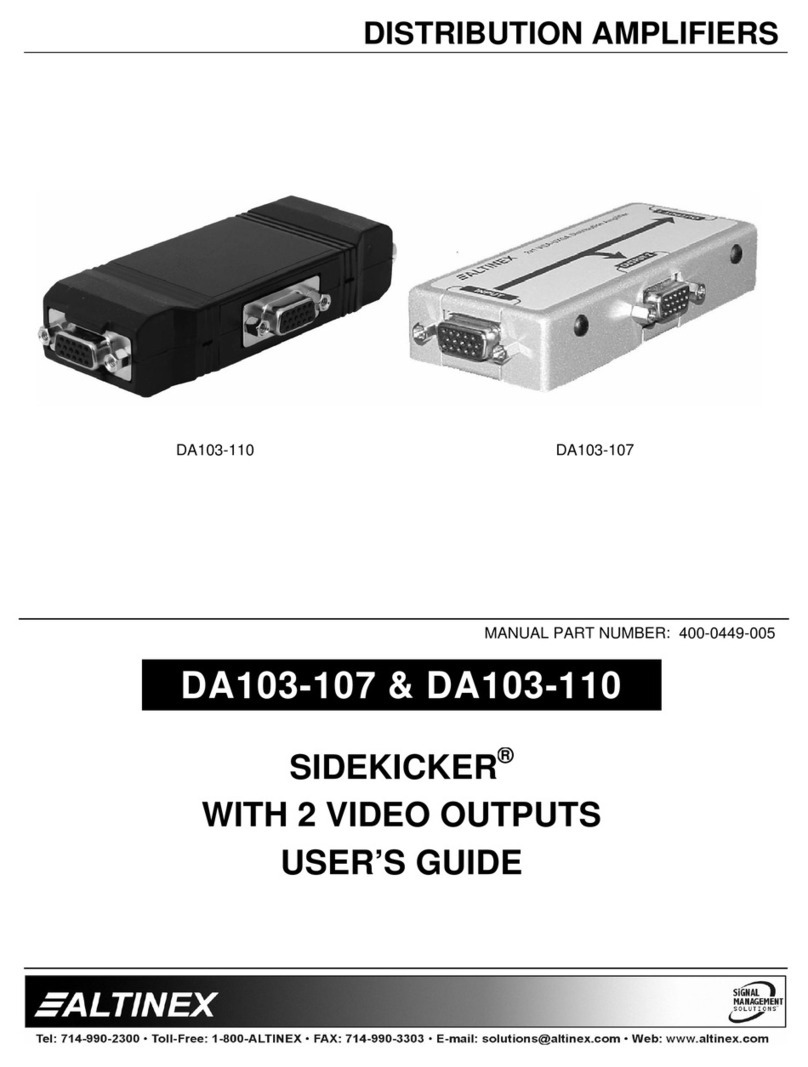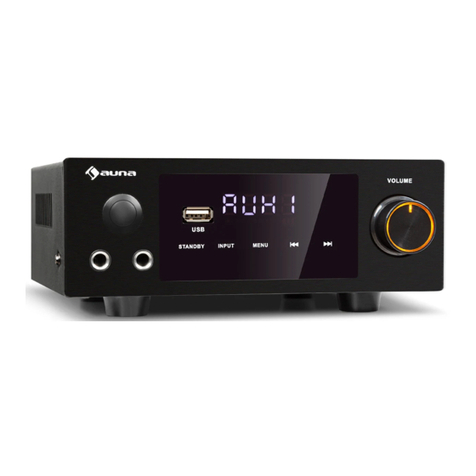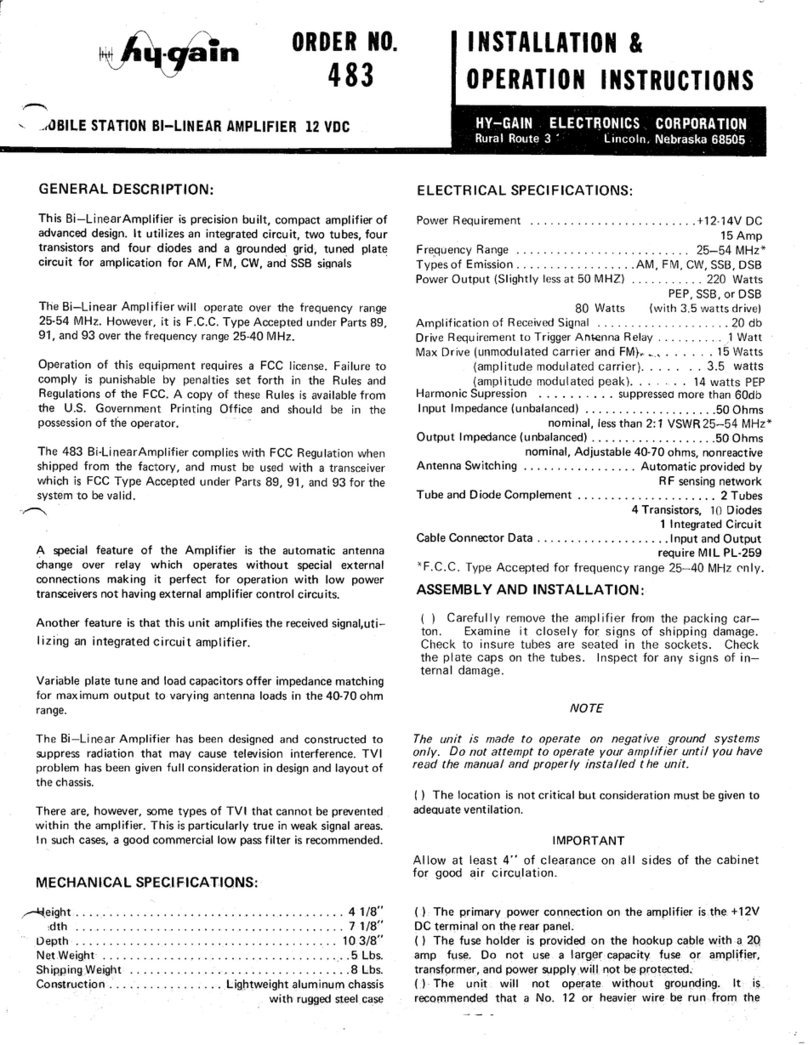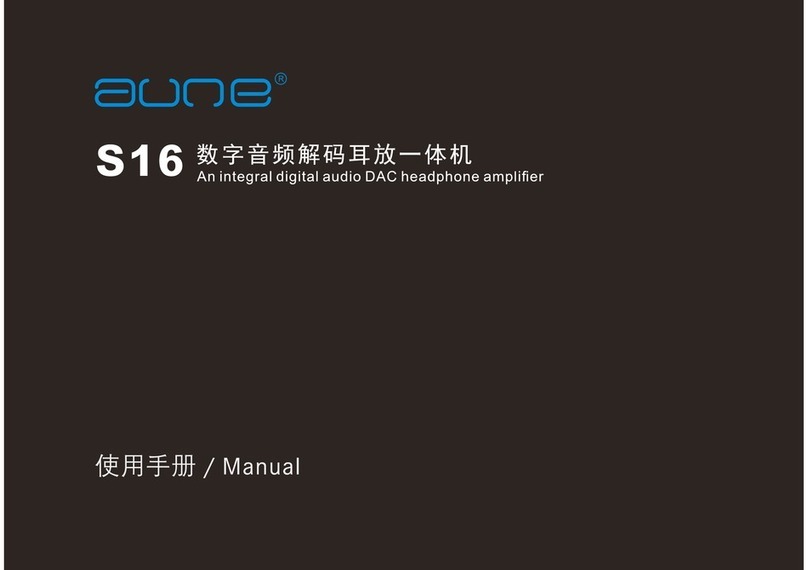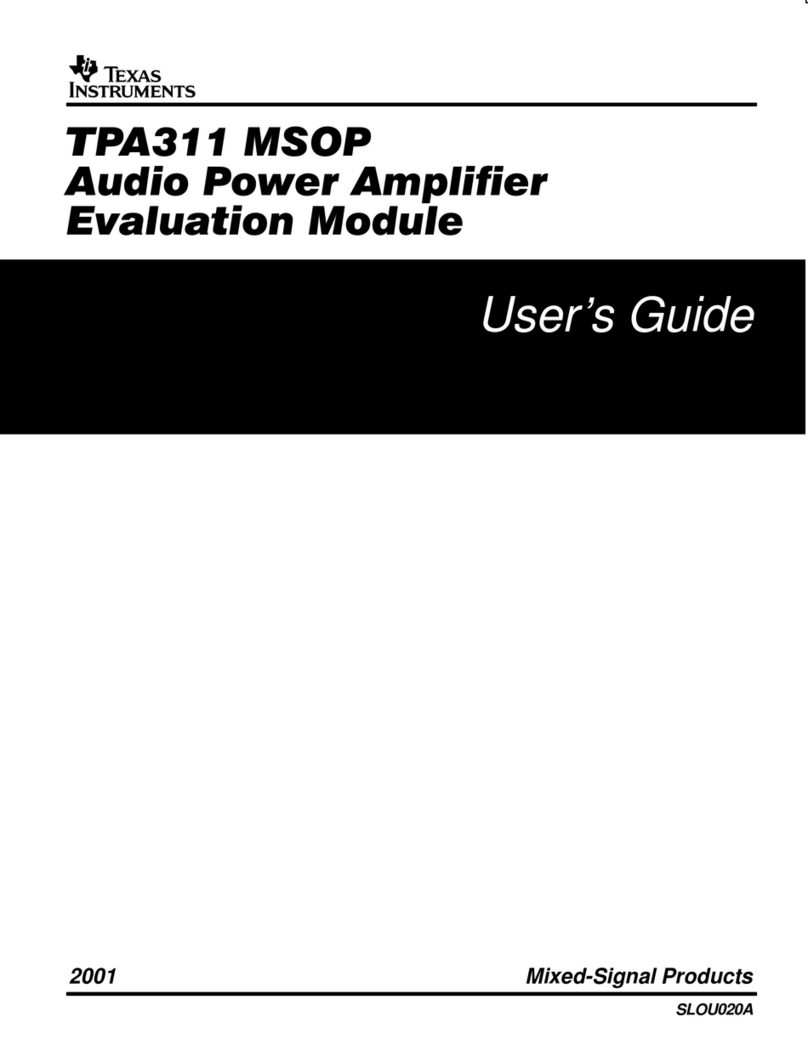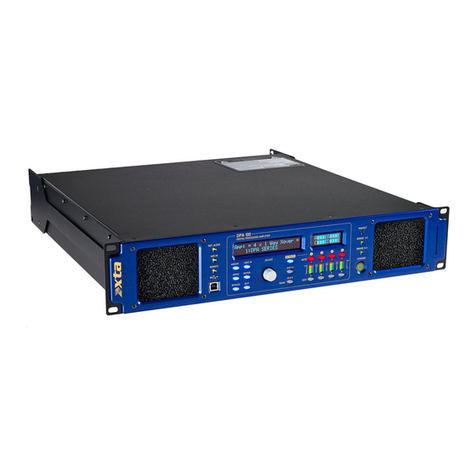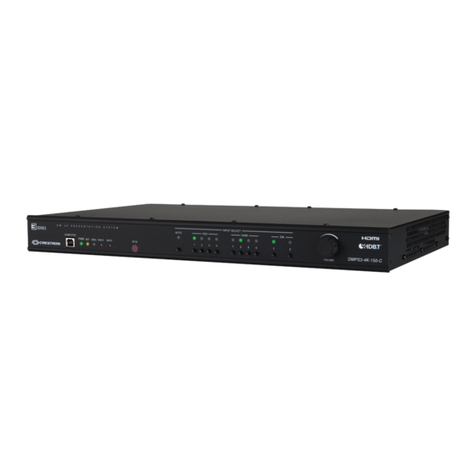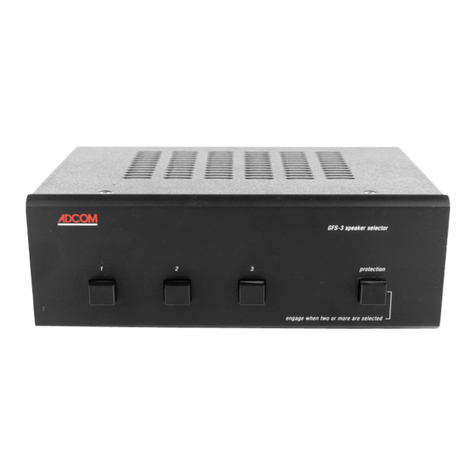DayTronic 3000 series User manual

MODEL
3170
STRAIN GAGE CONDITIONER
SB.5.1
INSTRUCTION MANUAL
3000
Instrument Series

Copyright © 1996, Daytronic Corporation. All rights reserved.
No part of this document may be reprinted, reproduced, or used in any form or by
any electronic, mechanical, or other means, including photocopying and recording,
or in any information storage and retrieval system, without permission in writing
from Daytronic Corporation. All specifications are subject to change without notice.

Correction
to Model 3170 Instruction Manual, v. SB.5.1
The I/O Wiring Data in Fig. 4 of this manual does not give the correct shield pairing of
cable wires, which is shown in the revised diagrams below and on the following page:
1
A
2
B
3
4
C
9
A
D
B
C
+EXC
–EXC
+SENSE
–SENSE
+SIG
–SIG
CAL SENSE
.
.
.
A
Extra Wire, paired
with CAL SENSE,
unconnected at
Connector A
SHIELD
Bendix PT02E-10-6S
Burndy BT06AC-10-6S
Daytronic 400 Series
Transducer Connections
1
A
2
B
3
4
C
9
D
A
B
C
+EXC
–EXC
+SENSE
–SENSE
+SIG
–SIG
CAL SENSE
.
.
.
A
Extra Wire, paired
with CAL SENSE,
unconnected at
Connector A
SHIELD
Amphenol 97-3106A-
14S-6S, AN3057-6
Daytronic 500 Series
Transducer Connections
(cont’d)

Correction
to Model 3170 Instruction Manual, v. SB.5.1 (cont’d)
+SENSE
–EXC
–SENSE
+SIG –SIG
CAL
SENSE
1
A
2
B
3
C
4
9
.
.
.
A
SHIELD
+EXC
Daytronic 3X70 Instrument to Generalized Strain Gage Transducer
4-Wire Configuration for Cables
Shorter Than 20 Feet
+SENSE
–EXC
–SENSE
+SIG –SIG
CAL
SENSE
1
A
2
B
3
C
4
9
.
.
.
A
SHIELD
Extra Wire, paired with CAL SENSE,
unconnected at Connector A
+EXC
6-Wire Configuration for Cables
Shorter Than 20 Feet
+SENSE
–EXC
+SIG –SIG
CAL
SENSE
1
A
2
B
3
C
4
9
.
.
.
A
SHIELD
Extra Wire, paired with CAL SENSE,
unconnected at Connector A
–SENSE
+EXC
8-Wire Configuration for Cables
Longer Than 20 Feet

MODEL
3170
STRAIN GAGE CONDITIONER
INSTRUCTION MANUAL
Model 3170 Instruction Manual, v. SB.5.1
Pub. No. 3170M.5.1, Issued 03/01
Part No. 91132
Daytronic Corporation
Dayton, OH • Tel (800) 668-4745
www.daytronic.com

Daytronic Corporation
TABLE OF CONTENTS
Section Page
1
Description ................................................. 1
2
Installation and Cabling ......................................
3
3
Calibration .................................................. 8
4
Block Diagram Description ................................... 12
5
Verification of Normal Operation ..............................
14
LIST OF ILLUSTRATIONS
Figure
Page
1
Model 3170 Strain Gage Conditioner...........................
1
2
Instrument Mounting Dimensions ............................. 4
3
Instrument Panel Mounting .................................. 5
4
I/O Wiring Data ............................................
.
9
5
Front-Panel Description ...................................... 11
6
Block Diagram .............................................. 15
7
Star-Bridge Construction ..................................... 17
LIST OF TABLES
Table
Page
PLEASE NOTE: Sections 6 and 7, Figures 8 and 9, and Table 2 have been
removed from this manual.
If you need information regarding specific 3170 components and circuitry,
please contact the Daytronic Service Department at (937) 293-2566.
1Specifications ............................................... 2

Daytronic Corporation
INSTRUCTION MANUAL
MODEL 3170 STRAIN GAGE CONDITIONER
1. DESCRIPTION
The Model 3170 conditioner-amplifier module for use with resistance strain
gage transducers. It supplies a regulated dc excitation voltage to the transducer
bridge, provides the necessary balancing and calibration controls, and amplifies the
resulting signal to a standard Five-Volt Data Signal Level which is the output analog
signal level of 3000 Series Modules. The
3170
has three separate analog outputs,
each having a different bandpass: (1) dc to 2
kHz,
(2) dc to 200 Hz, and (3) dc to 2
Hz. Active low-pass filters are used to achieve the 200 Hz and 2 Hz cutoff
frequen-
cies.
The filtered outputs provide for averaging or smoothing signals containing
noise or other unwanted dynamic components which are periodic in nature. Filter-
ing removes these dynamic components so that stable digital indication and precise,
jitter-free control action can be obtained. The Model 3170 is shown in Figure 1 and
the specifications are given in Table 1.
Figure 1. Model 3170 Strain Gage Conditioner
1

Model 3170
Table
1.
Specifications
Transducers: 4-arm bridges, 90
to
2000 ohms, nominally 1
to
8
mv/v,
full
scale (120 ohms or less requires use of 5-volt excitation).
Cables:
4-,
5-,
or 7-wire, depending on application; 1000
feet
maximum length.
Bridge Excitation: Regulated 5 volts or 10 volts dc, selected
with
I/O
connector wiring. Transducers
with
sensitivity from 4 to 8
mv/v
full
scale must use
5-volt
excitation.
Balance Adjustments:
10-turn
coarse and fine; will balance 1.5
mv/v
initial unbalance.
Span Adjustments:
10-turn
coarse and fine; 1to 8
mv/v,
full scale.
Analog Outputs: Three analog outputs available; 0 to ±5 volts with
50% overange,
5
milliamperes maximum.
Bandpass
is dc
to
2 kHz, dc
to 200 Hz, or dc to 2 Hz, depending on
output
used. Active low-pass
filters provide for rolloff of 60
dB
per decade above cutoff frequency.
Full-scale slew
time
is 1.4/f seconds, where f is
the
cutoff frequency.
Common Mode Rejection: Greater
than
80
dB.
Output Ripple and Noise: 0.15% of full scale (rms) maximum for
2-kHz and 100-Hz outputs; 0.02% of full scale (rms) on 2-Hz output.
Accuracy: 0.05% of full scale.
Dimensions: 1.7 x 4.41 x 8.5 (HWD inches).
Operating Temperature Range: 0 to + 130 degrees F.
Power Requirements: 105 to 135 volts ac, 50 to 400 Hz at 5 watts
maximum.
2

Daytronic Corporation
Remote sensing techniques are used to regulate the excitation voltage at the
transducer. Either a 10-volt or a
5-volt
excitation voltage can be selected by
appropriate wiring at the module
I/O
connector. The excitation voltage is protected
against overloads and accidental short circuits.
The 3170 uses a CMOS chopper-stabilized differential signal amplifier which
has over
100-megohms
input impedance per input line. This circuit guarantees
negligible drift with temperature variations or component aging.
Calibration of the 3
170
is accomplished by the conventional shunt technique,
using an internally installed calibration resistor. A front-panel CAL button or
Remote
Cal
terminals on the module I/O connector can be used to initiate the
calibration procedure.
The 3
170
Strain Gage Conditioner is also available in two additional forms. The
Model 3270 includes the addition of a digital indicator to view the analog output of
the conditioner. The Model 3370 includes a Limit section (in addition to a digital
indicator) which provides high, low, and ok indications and outputs. The digital
indicator and limit options are standard to all 3000 Modules and are covered in
separate instruction manuals.
2.
INSTALLATION AND CABLING
The following paragraphs provide the instructions for module installation and
cabling.
Module Mounting. The 3000 Series Modules can be operated as bench-top
instruments or they can be rack- or panel-mounted. Clearance dimensions for a
bench-mounted instrument are given in Figure 2. Panel cut-out dimensions for
panel mounting are also shown in Figure 2. Up to four 3000 Series instruments can
be mounted in a
19-inch
rack using the
1.75
-inch high Model 3004 Rack Adaptor.
Rack-mounting dimensions are also given in Figure 2. To panel mount an instru-
ment, proceed as follows. Refer to Figure 3.
Important: The unit is shipped with two spacer washers on the securing screws of the
rear-panel I/O Connector. When panel-mounting the unit, you MUST REMOVE
THESE WASHERS, so that the printed-circuit board may move forward about 1/8"
during Step (f).
(a)
Remove the front panel by removing the two 2-56 x
3/8
flat-head screws.
3

4
Model 3170
Figure 2. Instrument Mounting Dimensions
C. Panel Mounting
B. Rack Mounting
A. Bench Mounting

Daytronic Corporation
5
Figure 3. Instrument Panel Mounting

Model 3170
(b) Remove the front bezel by removing the four 6-32 x 5/8 fillister-head
screws.
(c) Make the panel cutout and drill the screw clearance holes indicated in
Figure 2. The front bezel can be used as a template to define the
rectangular cutout and locate the clearance holes.
(d) Hold the module enclosure behind the panel and reattach the front bezel
to the enclosure from the front of the panel with the four mounting
screws.
(e) Reinstall the front panel.
(f) Tighten the two securing screws of the rear-panel module I/O connector
to insure that the connector is seated and that the module printed-circuit
board is pushed fully forward so that the front-panel screwdriver ad-
justments and buttons are accessible. These screws give approximately
1/8-inch of adjustment; consequently, this is the maximum panel width
which should be used.
CAUTION
Do not overtighten the connector securing screws or resultant
damage may occur to the printed-circuit board.
AC Power Connection. To protect operating personnel, the 3000 Series Mod-
ules are equipped with a three-conductor power cord. When the cord is plugged into
the appropriate receptacle, the instrument is grounded. The offset pin on the power
cord is ground. To maintain the safety ground when operating the module from a
two-contact outlet, use a three-prong to two-prong adaptor and connect the green
pigtail on the adaptor to ground.
To prepare the module for operation, connect the power cable to a 105-135 volt
ac, 50-400 Hz power source. The instrument can use up to
5
watts of power.
Calibration Resistor. If a fixed resistor is shunted across one arm of a strain
gage bridge, it produces an unbalance equivalent to that of a particular value of
mechanical input. If this Equivalent Input value is accurately known, it can be used
as a reference point for shunt calibration of the system. Upon completion of
installation of the transducer and its associated cabling, the user can:
6

Daytronic Corporation
(1) Perform an overall
dead
weight calibration using a precisely known
value of mechanical input. The calibration can then be transferred to the
installed shunt calibration resistor for convenience in subsequent check-
ing.
(2) Replace the installed calibration resistor with one (or an equivalent
resistance value) supplied by the transducer manufacturer to achieve a
precisely known Equivalent Input, allowing the instrument sensitivity to
be adjusted correctly.
(3) Determine the
Equivalent
Input value for the installed calibration resis-
tor, knowing the transducer sensitivity, and adjust the instrument sen-
sitivity accordingly.
A precision 59-kilohm calibration resistor is installed in the 3170 at the factory.
The installed resistor can usually be used even though the transducer calibration
data mentions some other resistance value. In Section 3 of this manual, the tech-
niques described above are demonstrated. If, however, the installed value of
calibration resistor is not appropriate, the
59-kilohm
resistor should be replaced at
this time by one that is appropriate for the transducer and measurement range to be
used. The calibration resistor is mounted on terminals located at the front edge of
the strain gage conditioner printed-circuit board. It can be accessed by removing
the module front panel.
Transducer Cabling. Cabling to the transducer is accomplished via the
supplied module I/O connector. The I/O connector pin numbers and functions are
given in Figure 4. When Daytronic 400 or 500 Series Transducers are used,
factory-wired cables are available as shown in Figure 4. When user-fabricated
transducer cabling is used, it should take the form of either the 4-, 5-, or 7-wire cable
configuration shown in Figure 4.
The 4-wire configuration should be used when overall dead weight calibration
is the method used and the required cable length is less than 20 feet. The 5-wire
configuration should be used when the instrument is to be calibrated by achieving a
precisely known
Equivalent
Input value through the use of a shunt calibration
resistor (or resistance value) supplied by the transducer manufacturer and when the
required cable length is less than 20 feet. The 7-wire configuration should be used
with cable lengths longer than 20 feet since the excitation voltage is sensed and
regulated at the transducer and optimum shunt calibration can be achieved.
7

Model 3170
Transducer Excitation. Either
5-volt
or 10-volt bridge excitation can be
selected. In general,
5-volt
excitation is used with
120-ohm
transducers, and the
10-volt excitation is used with 350-ohm devices. However, for any transducer
which has a 4
mv/v
or higher sensitivity,
5-volt
excitation must be used to maintain
proper operation without saturating the conditioner amplifiers. Five-volt excitation
is selected by shorting pins D and E of the module I/O connector (see Figure 4).
Ten-volt excitation is achieved when pins D and E are not connected together.
Remote Calibration Check. The instrument can be remotely placed in the
calibration mode by shorting pins 5
(Signal
Common)and 8 (Remote
Cal)
of the
module I/O connector. Figure 4 indicates three methods of remotely entering the
calibration mode through the use of an external switch, transistor, or TTL source.
The
Remote
Cal
function provides a convenient method for periodically monitoring
calibration of the instrument.
Analog Outputs. Three different analog outputs are available at the module
I/O connector. Each output has a different passband: dc to 2 kHz, dc to 200 Hz, and
dc to 2 Hz. The 200 and 7 Hz cutoff frequencies are achieved with active low-pass
filters. As the cutoff frequency is lowered, a trade off is made between noise
elimination and increased time-to-answer or slew time. Each output has a
60-dB
rnlloff a decade from the cutoff frequency. The filter characteristics are given by the
following equations.
A
out
@ f
0
= 0.7 A
in
A
out
@ 10f
0
= 0.001 A
in
T = 1.4/f
0
where A
out
= output amplitude
A
in
= input amplitude
f
0
= selected cutoff frequency
T = time-to-answer in seconds (output of filter within 0.1%
of final value after step function is applied).
3. CALIBRATION
This section contains the instructions for calibrating the 3
170
Included is a
functional description of the module front panel (see Figure 5). To perform calibra-
tion, proceed as follows.
(a) Turn power ON by placing the rear-panel slide switch in the ON posi-
tion. The front-panel indicator should light to indicate the application of
8

Figure 4 I/O Wiring Data
See the CORRECTION to Fig. 4 in the front of this manual.

Figure 4 (cont'd)
See the CORRECTION to Fig. 4 in the front of this manual.

Daytronic Corporation
BALANCE Controls:The coarse
(R
c
)
and fine
(R
f
)
BALANCE controls are
used to set the module output to zero when the transducer is unloaded.
SPAN Controls: The coarse (c) and fine (f) SPAN controls are used to set
the output to the
Equivalent
Input
value when the CAL button is pressed.
CAL Pushbutton: The CAL pushbutton provides for enabling or entering
the calibration mode. The Cal resistor is shunted across the + Signal
and
+Sense terminals when the button is pressed, supplying an Equivalent
Input value to the module.
Figure
5.
Front-Panel Description
ac power. Allow
5
minutes of warm-up for stabilization of transducer
characteristics.
(b)
With the transducer unloaded, set the module output to zero using the
coarse
(R
c
)and fine (Rf) BALANCE controls. In some instances, an
integral digital indicator will be used to display the conditioner output
(Model 3270 or 3370). When only the conditioner is supplied
(3170),
an
external indicator must be used to monitor the conditioner output.
(c)
Load the transducer to a convenient up-scale value which is greater than
one half of full scale. Adjust the coarse (c) and fine (f) SPAN controls
until the output signal causes a reading equal to the
dead
weight value.
Remove the
dead
weight, then press the CAL button and note the
indicator reading obtained. This reading can now be used in future
calibrations since it is related to a value obtained thru
dead
weight
11

Model 3170
calibration. To calibrate the instrument in the future, simply press the
CAL button and adjust the SPAN controls to obtain the reading previ-
ously recorded after dead weight calibration.
(d) If dead weight calibration is not practical and the transducer manufac-
turer has supplied a calibration resistor (or resistor value), install the
recommended calibration resistor. Now press the CAL button and
adjust the SPAN controls until the module output is equal to the
Equiva-
lent Input value simulated by the installed calibration resistor.
If dead weight calibration is not practical and the transducer calibration
data is unknown, the
Equivalent
Input value for the factory-installed
calibration resistor can be approximated as follows, assuming that the
mv/v
sensitivity rating of the transducer and the bridge resistance is
known.
X =
where X = Equivalent Input, % of full scale
R
b
= bridge resistance, ohms
K = transducer sensitivity, mv/v full scale
R
c
= calibration resistance, ohms (59 K installed)
25000 R
b
Sample Calculation: Assume that K = 3.000
mv/v
for a
5000-pound
load cell
(full scale) with a bridge resistance of 350 ohms.
25000 x 350
59000 x 3 = 49.44% of full scale = 2472 pounds
4. BLOCK DIAGRAM DESCRIPTION
The purpose of this section is to explain how the 3170 works by using a
simplified block diagram of the conditioner. This is not intended to be used as a
detailed theory of operation discussion for personnel untrained in electronic
technology, but as a simplified explanation of the detailed schematic diagram
provided with this manual.
Refer to Figure
6.
Primary power (115 volts ac,
50-400
Hz) is applied to the
module by means of the attached power cable. A rear-panel slide switch is used to
turn ON primary power. Overload protection is provided by a 0.25 ampere fuse
12
K R
c
X =

Daytronic Corporation
mounted on the conditioner printed-circuit board. When the slide switch is ON,
primary power is applied to the power transformer which provides the necessary
power-line isolation and the low ac voltages required to develop the regulated dc
voltages used in the module. The secondary of the power transformer has a
grounded center tap, and a diode bridge functions as two full-wave rectifiers to
produce
±
9 volts regulated dc. Two three-terminal regulators are used to develop
these regulated voltages. The reference terminal of each regulator is biased with one
or two diodes to make certain that a minimum regulated voltage of 9
volts
is
achieved. The proper diode biasing is accomplished at factory check out.
A dc reference voltage of
+2.5
volts dc is further developed from regulated +9
volts by the use of a third three-terminal regulator. This precision dc reference is
used to bias an amplifier/driver which works in conjunction with a series-pass
regulator to regulate the excitation voltage at the transducer bridge. The excitation
voltage is normally 10 volts dc, but a jumper can be installed at the module I/O
connector to select a
5-volt
excitation voltage. The excitation voltage is developed
from the minus unregulated side of the diode bridge to more equally balance the
current drain on the power transformer secondary. The series-pass regulator has
short-circuit protection in the event that the excitation voltage is accidentally
shorted at the transducer or module
I/O
connector.
Figure 6 shows the connections between the transducer bridge and the module
made via a 7-wire cable. Optimum accuracy is obtained with the 7-wire configura-
tion since the excitation voltage is regulated at the transducer bridge and a
Cal
Sense line is returned to the module for accurately setting the Equivalent Input
value when the Cal resistor is shunted across one leg of the transducer bridge. The
Calibration mode is entered (Cal resistor is shunted across the + Signal and +
Sense lines) when the front-panel CAL button is pressed or the Remote Cal input at
the module
I/O
connector is brought to a zero-volt level through the action of an
external switch, transistor driver, etc. Either of these actions fires a comparator
which, in turn. closes an analog switch in series with the Cal resistor.
The + and – Signal inputs from the transducer bridge are applied to a differen-
tial signal amplifier. Each leg of the signal amplifier inputs has approximately
100-megohms input impedance so that no loading is seen by the bridge. The signal
amplifier is chopper stablized to prevent drift which might result from temperature
or component aging. A two-phase clock signal synchronized with power line
frequency is used as the chopper signal. The differential signal amplifier also
provides excellent common-mode rejection.
13

Model 3170
The bridge balance circuit immediately follows the signal amplifier. The BA-
LANCE and SPAN controls act upon the output of the signal amplifier, not the
bridge, to achieve the proper impedance isolation.
Three analog outputs of the conditioned strain gage signal are available at the
module I/O connector. The three outputs provide three different passbands of dc to
2
kHz,
dc to 200 Hz, and dc to 2 Hz. Output selection is a trade off between
eliminating unwanted signals caused by vibration or increasing the time-to-answer
(slew rate) of the conditioner. The 200-Hz and 2-Hz cutoff frequencies are achieved
with the use of active low-pass filters. The
rolloff
of each output is 60
dB
within a
decade of the cutoff frequency.
5.
VERIFICATION OF NORMAL OPERATION
It is the purpose of this section to aid the user in determining, in the event of a
malfunction to which the Model 3170 is suspected of contributing, whether the
module is functioning normally or whether it is a source of the observed trouble. In
the event the module requires repair, a complete parts list, schematic diagram, and
component location drawing are included in this manual. The user may also contact
the factory Service Department or the local Daytronic Representative for assis-
tance.
If the module is suspected of faulty operation, observe the following steps.
(a)
If the module is totally inoperational (front panel power indicator does
not light), check the primary power fuse (Fl) located on the conditioner
printed-circuit board (see Figure 8). If the fuse is blown, replace it with a
0.50 ampere fuse. Before reapplying power, visually inspect the power
cord wiring and the printed-circuit board for any discrepancy which
could have caused the overload.
(b)
If the transducer has some preloading, the BALANCE controls may not
allow successful zeroing of the module output. This condition can be
remedied by connecting a resistor (50 K-200 K range, metal-film type)
from the + Signal terminal of the transducer to the + or – Excitation
terminals. The Excitation terminal to which the connection is made is
determined by the direction of the loading or off-zero reading.
(c)
The inability to balance correctly where the module output reads totally
off scale and the BALANCE controls have no authority can very likely
be the result of a damaged or defective transducer or cable. This
possibil-
14
Other manuals for 3000 series
2
This manual suits for next models
1
Table of contents
Other DayTronic Amplifier manuals
Popular Amplifier manuals by other brands
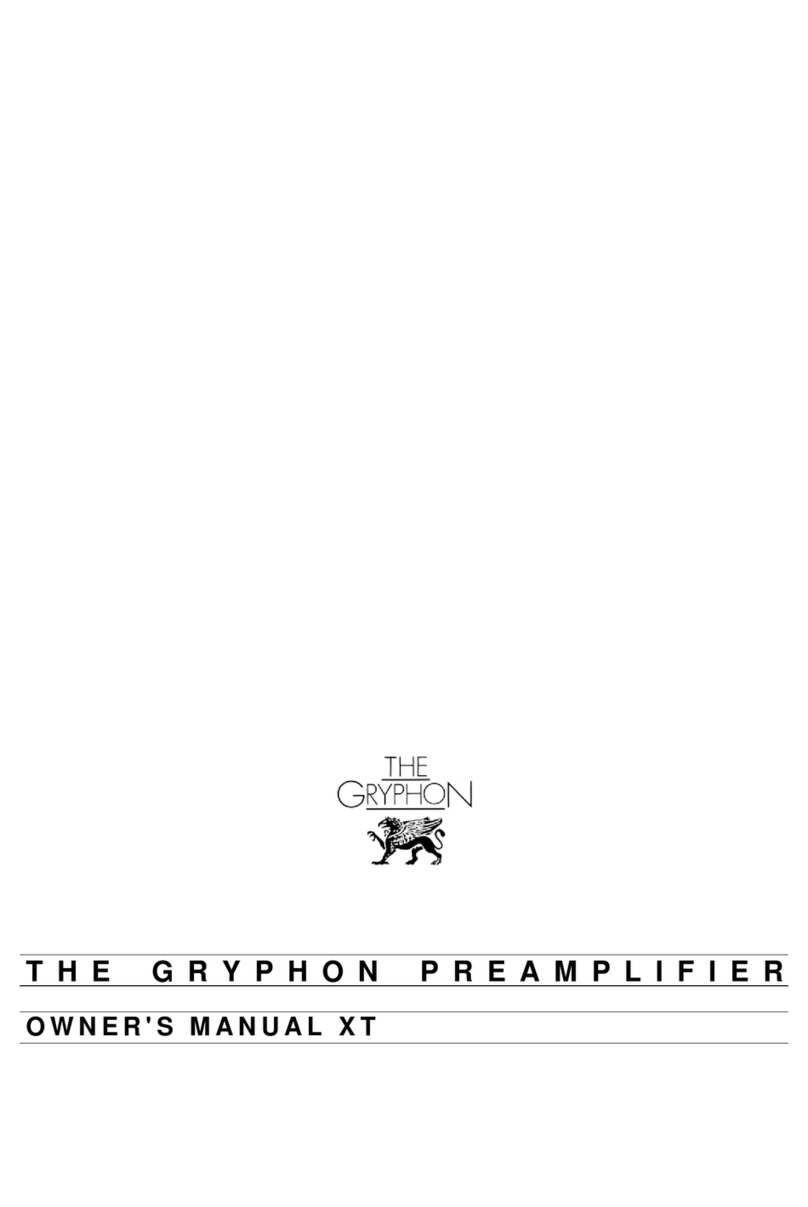
Gryphon
Gryphon XT owner's manual
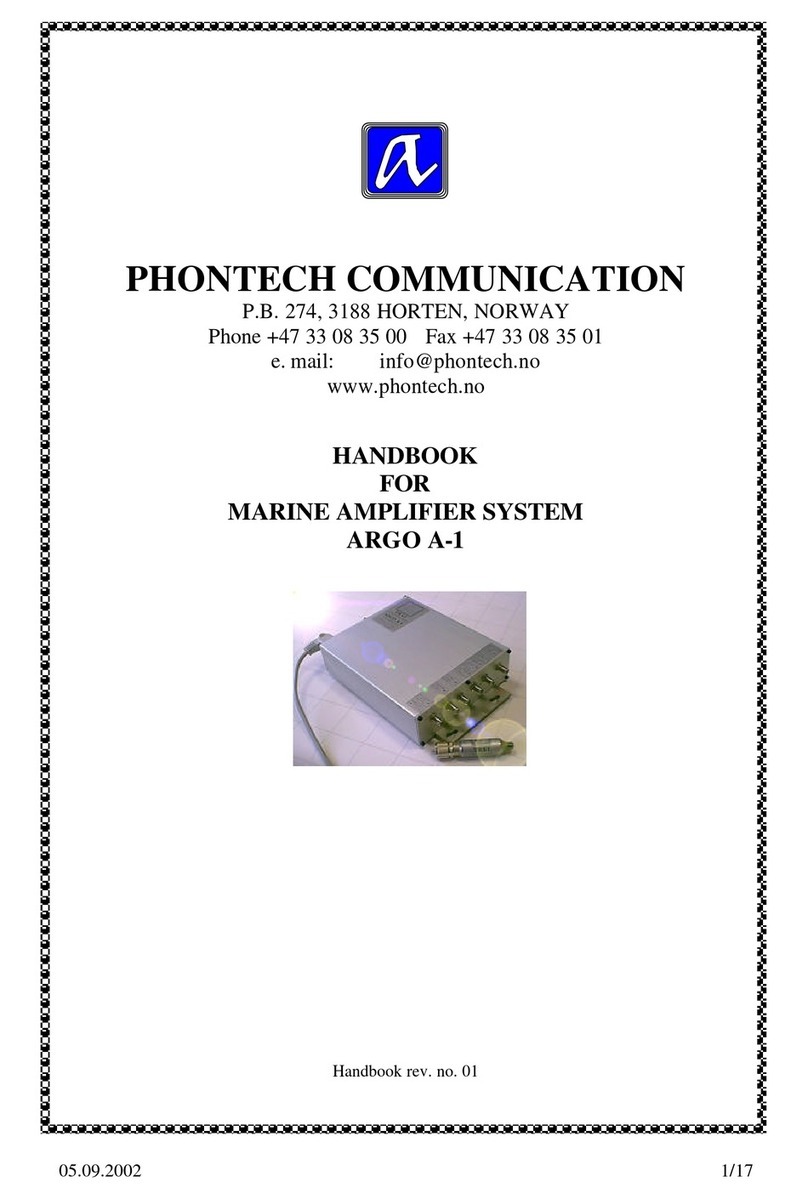
Phontech Communication
Phontech Communication Argo A-1 Handbook

Audio Note
Audio Note SORO Phono SE Signature Owner's Information

Elliott Studio Arts
Elliott Studio Arts 66-001P owner's manual
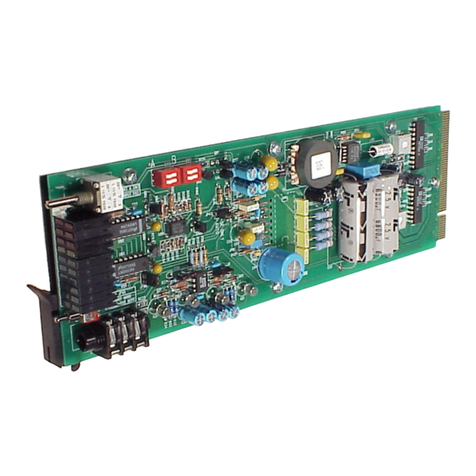
Link electronics
Link electronics DigiFlex 1626 Specification sheet

Racal Instruments
Racal Instruments 5601 user manual

